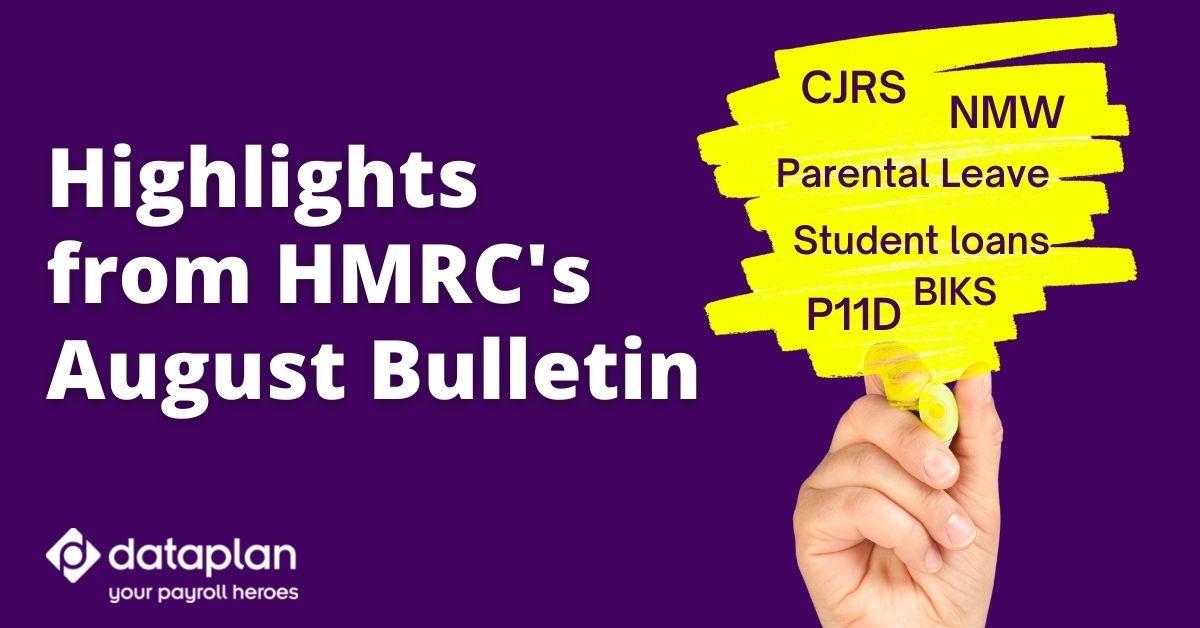
Every month HMRC releases a bulletin with important updates and information for employers across all sectors.
The in-depth document covers each topic in detail, and it can be hard to pick out which points are relevant to you. To make this easier our team of experts have looked closely at the August 2021 bulletin and pulled out the points that you might find helpful!
To read the full bulletin visit the gov.uk website.
Coronavirus Job Retention Scheme
As we have detailed in our past blog post, the Coronavirus Job Retention Scheme (CJRS) was extended till the end of September 2021. This means that the scheme will soon come to a close and for August and September the amount of an employee’s wages that the Government will pay drops to 60% with a cap of £1,875.
Furloughed employees must continue to be paid 80% of their usual wages for the hours they do not work, up to a cap of £2,500 a month, so employers must make up the 20% difference.
We’ve also recently written a handy checklist for our clients to follow here.
COVID-19 and social security coordination with the EU
As COVID-19 continues to have an impact on travel with many restrictions still in place, this impacts the movement of workers between the UK and the EU.
For employers who have employees that normally work in the UK, EU or both and their work location has been changed temporarily due to COVID-19 travel restrictions, HMRC will consider individual circumstances to decide whether National Insurance contributions are due in the UK.
These arrangements will cease by the end of December 2021, but will continue to be reviewed as the situation with COVID-19 and travel develops.
Employees’ are responsible for applying for any National Insurance exemptions or changes themselves, then you as the employer will receive a letter from HMRC that needs to be provided to your payroll professional.
Student Loan types
In April 2021 changes were introduced that saw 4 types of student loans collected through the Pay As You Earn (PAYE) self-assessment system which are:
- Plan 1
- Plan 2
- Plan 4 (which was introduced in April 2021)
- Postgraduate loans
Each has a different threshold and in some cases different rates for calculating deductions. To avoid applying the wrong student loan potentially impacting an employee’s pay and causing them to pay a higher interest rate it is important to ensure the following:
- Check your online account for student loans and postgraduate loans, and start and stop notices
- Let HMRC known immediately if any email or physical correspondence address changes
- Initiate the correct action to start student and postgraduate loan deductions in a timely fashion
- Record the deductions correctly on your Full Payment Submission (FPS)
Of course, if you are a client of Dataplan Payroll, you don’t need to do any of the above yourself! Just make sure that we are authorised as your agent, and we will be able to automatically download all information from the HMRC Gateway. If for any reason you do receive a paper notification from HMRC, do scan and upload this to your secure portal, and make sure all new joiners complete a starter declaration.
You must ensure you are using the latest version of the starter declaration, which includes the new student loan type, Plan 4.
https://www.gov.uk/government/publications/paye-starter-checklist
Correct payment of National Minimum Wage to Apprentices
Despite the fact that all Apprentices are entitled to at least the National Minimum Wage, a Low Pay Commission report found that 1 in 5 Apprentices are earning less than their legal entitlement.
Mistakes are not uncommon and even for those Apprentices who are paid minimum wage rates or even above, the potential for underpayment can still pose a risk. It is important to keep up to date on legislative changes and check your payroll every pay period to ensure National Minimum Wage rates are being met.
You can use the Apprentice section of check your pay to see which National Minimum Wage rates apply to any apprentices within your business.
HMRC reports that the most common errors they encounter are:
- The failure to pay the higher age-related minimum wage rate to those aged 19 and over who have completed the first year of their apprenticeship
- The payment of the £4.30 per hour minimum wage apprentice rate before or after an apprenticeship finishes or starts
- Not paying for all of the time being worked by an apprentice, training time must be included as working time
It’s important to make sure your inform your payroll professional if a new joiner is an apprentice, and equally if an apprenticeship finishes and the employee continues on a regular contract. This ensures that the right National Minimum Wage can be applied.
Informal payrolling of benefits in kind
Since informal arrangements can only be in place for a maximum of one tax year HMRC expects businesses who have previously had an informal payrolling arrangement to register for formal payrolling before April 2022 for the 2022 to 2023 tax year.
They will only accept new informal payrolling arrangements for benefits in kind (BIKs) during the 2021 to 2022 tax year.
Reporting expense and benefits digitally
HMRC encourages businesses who do not already do so to consider payrolling their benefits in kind, or at least filing P11Ds and P11D(b) online. This increases the efficiency of the process in addition to cutting down on the cost of paper, printing and posting to HMRC.
The deadline for registration for 2023 is April 2022.
You can apply to payroll your benefits for next tax year through this link:
https://www.gov.uk/guidance/payrolling-tax-employees-benefits-and-expenses-through-your-payroll
Making your PAYE Settlement Agreement payment
PAYE Settlement Agreements (PSAs) allow businesses to make one annual payment covering all of their tax and National Insurance due on small or irregular taxable expenses or benefits for employees. For example if you give a long service award such as a £500 voucher, you would normally have to account for the benefit of the gift through the payroll, but with an agreement in place you could calculate the tax and NICs due and put them through your PSA submission in July for the company to bear the cost.
Where a PSA is in place, electronic payments for the tax year ending 5th April 2021 must clear into the HMRC bank account by the 22nd October 2021 to avoid interest, late payment penalties or both.
To pay your PSA you will need to use your unique PSA reference number which should be documented on the payslip sent to you by HMRC. It is important not to use your regular PAYE reference, and if you cannot find your PSA number you should instead contact the office dealing with your application for help and advice.
It should be noted that at the present time, PSA submissions still need to be sent by post to HMRC by the 31st of July each year, so do leave time for postage.
P11D(b) Penalty Warning letter
For employers who have not filed a return on or before the deadline of 6th July 2021 a penalty warning letter will be sent. It is not a penalty notice, rather a warning, but it will state if any penalties have already been incurred as well as a reminder to file their outstanding return to avoid further penalties.
The fastest way to file your return is online rather than using paper returns. HMRC recommends the following methods:
- Commercial payroll software
- HMRC’s PAYE online service
- HMRC’s online End of Year Expenses and Benefits service
It is important to note that even if you registered your payroll benefits for the 2020 to 2021 tax year, you still need to submit a P11D(b) to notify HMRC or the Class 1A National Insurance contributions that are due. Even if no contributions are due you should still submit a nil P11D(b) and complete the declaration.
Where an outstanding return is filed their penalty will be reviewed and updated as deemed appropriate.
To avoid penalties, speak to your payroll professional about using our P11d service next year.
Apply to the Kickstart Scheme to help your business grow
The Kickstart Scheme allows employers of all sizes to apply for funding to create new jobs for 16 to 24 year olds on Universal Credit. This funding covers:
- 100% of the National Minimum Wage or National Living Wage for 25 hours per week for a total of 6 months
- Associated employers National Insurance contributions
- Minimum automatic enrolment pension contributions
- £1,500 grant per job to cover the set-up costs and employability support
The scheme benefits both employers and young people, and the deadline for applications for the next tax year is October 2021.
If you take on a kickstart employee, let your payroll professional know if you need them to be allocated to their own department or division on the payroll, so that you can easily pick up the figures required to claim your reimbursement from the government.
New tool makes planning shared parental leave easier
The new tool launched by the Department for Business, Energy and Industrial Strategy (BEIS) is aimed at helping working families take full advantage of the Shared Parental Leave and Pay Scheme.
Employed parents or employers can use the tool to check their eligibility for the scheme in addition to seeing how many weeks of Shared Parental Leave and Shared Statutory Parental Pay are available to them. They can also agree how they will share the entitlement, and plan when to take their leave and pay.
The scheme is incredibly detailed and can be complex to understand, so this tool simplifies the process significantly taking less than 5 minutes to complete the eligibility check.
Remember you must ask your employee for their partner’s surname and National Insurance number when they submit a Shared Parental Leave and Pay request, and then you need to submit all of this to your payroll professional through your secure portal.
Dataplan are one of the UK’s leading providers of specialist payroll and associated services.
From payroll outsourcing and pension service management to ePayslips and gender pay gap reporting; we have a solution for you and your business.
